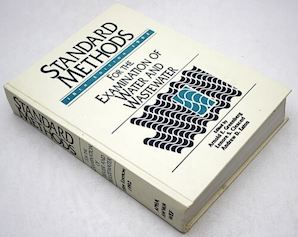
Curated with aloha by
Ted Mooney, P.E. RET

The authoritative public forum
for Metal Finishing 1989-2025

-----
Sodium Hydroxide: How to make to 0.5 M strength
(to provide context, hopefully helping readers more quickly understand the Q&A's)
A 'molar solution' or '1.0 M' solution is defined as a solution which contains one gram-equivalent weight of the substance in question dissolved in 1 liter of solution (the water).
The atomic weight of a molecule of sodium hydroxide, NaOH, would be the atomic weight of 1 atom of Na plus 1 atom of O plus one atom of H (the atomic weights can be obtained from the Periodic Table, or an appendix in the Metal Finishing Guidebook) as
22.997 + 16.000 + 1.008 or 40.005
-- let's round it to 40.
So a 1.0 M solution of sodium hydroxide contains 40 grams of sodium hydroxide per liter of water. Working with different strengths like 0.5 M (1/2 molar or 20 g/L) and different volumes is then a matter of simple arithmetic.
sometimes on
AbeBooks or Amazon
(affil links)

free pdf is currently available from academia.edu
Q. How to prepare 0.5 Mole of NaOH - to make 20 ml of solution.
My Query: Is it correct [we know that 0.5M NaOH is equal to 20 grams - it was dissolved in 20 ml of water] this statement is correct or not ? Please reply sir!
Researcher - Tamil Nadu, India
October 11, 2021
A. Hi Dr. Paul. The statement is incorrect.
We've now added a 'Tutorial' sidebar at the top of the page explaining the concept and offering the bottom line answer that a 1.0 M solution of sodium hydroxide contains 40 grams of sodium hydroxide per liter (1000 mL) of water, and the rest is just arithmetic.
Luck & Regards,

Ted Mooney, P.E. RET
Striving to live Aloha
finishing.com - Pine Beach, New Jersey
Tip: Readers want to learn from Your Situation 🙂
(little can be learned from abstract questions, so many readers skip them)
Q. Hi There. May I please have help with the following?
How many mL of water must be added to 10 grams of NaOH to make a 0.50 molar solution?
- Los Angeles, California
May 9, 2022
A. Hi Connie. We explain on this page how/why a 1.0 molar solution is 40 g of NaOH per 1000 mL, and that a 0.5 molar solution would be 20 grams per 1000 mL. If that doesn't do it for you, what step in the arithmetic are you having trouble with?
But remember that "How [much] water must be added ... to NaOH" is a dangerous way to pose the question! You add the NaOH to the water, you never add water to NaOH.
Luck & Regards,

Ted Mooney, P.E. RET
Striving to live Aloha
finishing.com - Pine Beach, New Jersey
![]() Much appreciated! Thank you!
Much appreciated! Thank you!
- Los Angeles, California
Q. I need to prepare 0.5 mol solution of NaOH from a prepared 1 mol solution of NaOH. I have no solid NaOH and need to prepare this in a volumetric flask, and I want to find out how much 1 mol NaOH and how much water I need to mix.
Dozer Peters- Iowa
May 20, 2022
A. Hi Dozer. That would depend on how much of it you need to prepare, wouldn't it?
When you understand what a "1 mol" solution actually means, and what a "0.5 mol" solution actually means, the answer will be very obvious, and we are happy to take as much time trying to explain this as you need. But it would be a disservice for us to tell students whether to divide by two or to multiply by two so they can answer their homework questions without them putting in any effort to understand the question. Let's put in equal parts here.
Luck & Regards,

Ted Mooney, P.E. RET
Striving to live Aloha
finishing.com - Pine Beach, New Jersey
⇩ Related postings, oldest first ⇩
Q. Hello Folks,
Can anybody help me to make a 0.5 M NaOH solution, I forgot that formula?
Thanks,
Reynaldo Arroyo- Valencia, California, U.S.A.
2002
|
|
A. NaOH has a valence of 1, so molar and Normal are the same. One mole of NaOH in one Liter of pure water = 1N. Since you want 0.5, use 1/2 mole (20.0 grams) of NaOH. If this is for a titration, you will need to standardize it. By the time you make it up, filter it (if required), cool it and then standardize it, you will find that it is cheaper to buy the premade solution from VWR-SP or Fisher or ?. James Watts- Navarre, Florida A. Dissolve 20 g NaOH to a total volume of 1 L in water.  James Totter, CEF - Tallahassee, Florida |
|
|
A. Dear Mr Arroyo, One mole of NaOH weighs 23(Na)+16(O)+1(H)=40 g Kind regards,  Sjamp van Esch - Eindhoven, The Netherlands A. M means Gram Molecular Weight, so 0.5 M means half the gram molecular weight of the chemical. In the case of NaOH the mole. wt. is Na=23, O = 16, H =1, so NaOH = 40. Half of that is 20, so 0.5 M NaOH is the same as 20 g/l. I trust you now remember your basic chemistry.  Trevor Crichton R&D practical scientist Chesham, Bucks, UK |
Q. Please help me with my research: How are we going to prepare a half molar NaOH?
Angel de Silva- Davao City, Philippines
September 17, 2013
A. Hi cousin Angel. A "half molar" solution is exactly the same as a "0.5 M" solution, so this was already answered by 4 helpers. If you remain confused, please explain in what way these answers are proving unsatisfactory. Thanks.
Regards,

Ted Mooney, P.E.
Striving to live Aloha
finishing.com - Pine Beach, New Jersey
A. To make 0.5 M of NaOH, measure 20 g of sodium hydroxide and dissolve it in 1000 ml of water; we have used 20 g because the RMM [relative molar mass] of NaOH is 40 and we are making 0.5 M solution.
cyprian nthuli- mombasa , kenya
March 26, 2015
Q. How many grams NaOH are needed to prepare 500 ml of 0.5 M NaOH
Jelo pabular- Cebu city, Philippines
September 29, 2015
![]() Jelo, I know that you know that to make half as much quantity of anything, you just use half as much of the ingredients.
Jelo, I know that you know that to make half as much quantity of anything, you just use half as much of the ingredients.
Maybe these students are just pulling our leg now, rather than being unable to divide by two. Thank god I didn't go into teaching; I wouldn't last the first day :-)
Regards,

Ted Mooney, P.E. RET
Striving to live Aloha
finishing.com - Pine Beach, New Jersey
Q. Dear Friends,
I have a Query regarding the Sodium hydroxide solution preparation. I prepared the sodium hydroxide solution with respect to 15 gram per liter and poured into a glass bottle, after 2 days I titrated it to find out the concentration of NaOH and surprisingly found that NaOH conc. reduces to 10 g/l and even I found aluminum as 4 g/l, so can somebody explain me how this aluminium introduced into this solution?
- Abu dhabi, UAE
December 20, 2015
A. Hi Aijazullah. It's obviously either experimental error or a jar which contained reactable aluminum. Good luck.
Regards,

Ted Mooney, P.E. RET
Striving to live Aloha
finishing.com - Pine Beach, New Jersey
Q. How to make 20% sodium hydroxide solution from a 1N solution?
Tammy Lee- Birmingham, Alabama, USA
April 20, 2016
A. Hi Tammy. As you can see from the 5 explanations above, your 1N solution is 40 g / 1000 g or 4% by weight. You could heat it and evaporate the water until it was 20% NaOH by weight, but I doubt that evaporating the water from a dilute caustic solution to make a more concentrated and dangerous one would be approved by your university these days. Good luck.
Regards,

Ted Mooney, P.E. RET
Striving to live Aloha
finishing.com - Pine Beach, New Jersey
Q. How do I prepare 0.4 mol/l of NaOH? Someone help please.
UMAHI O [last name deleted for privacy by Editor]diagnostic center - Nigeria
April 3, 2017
A. Hi cousin Umahi. The calculation for this has been explained 6 times on this page now. Please take the time to read it then tell us what it is that you are not understanding. I'd be worried about the sufficiency of my haz-mat training if I were you because this is pretty basic stuff you should know before you start working with hazardous chemicals. Good luck.
Regards,

Ted Mooney, P.E. RET
Striving to live Aloha
finishing.com - Pine Beach, New Jersey
AWWA

on AbeBooks
or eBay or
Amazon
(affil links)
A. The best way is to make a 50% w/w solution of NaOH in DI water, allow it to cool, let any solids settle out (Na2CO3) and then weigh out 8.0 g of this prep into a volumetric flask. Make up to the mark with DI, with lots of swirling, let cool, then make up to the mark again.
For maximum accuracy, a standardization vs. KH pthalate would be advisable. Check "Standard Methods" for this procedure.
This is really kind of basic Chem 101 stuff, if I may say.

Dave Wichern
Consultant - The Bronx, New York
Q. I have a 5% solution of Sodium Hydroxide w/v.
I would like a 1.5% solution of Sodium hydroxide.
How do I solve this?
- Tualatin, Oregon, USA
April 4, 2017
A. Hi Stan. I guess you're saying you have a solution with 50 grams of NaOH for every 1000 mls? And you would like to dilute it to the point where you have only 15 grams of NaOH for every 1000 mls?
So for every 15 mls of solution of 5% solution you wish to dilute, add 35 mls of water to end up with 50 mls of 1.5% solution.
Regards,

Ted Mooney, P.E. RET
Striving to live Aloha
finishing.com - Pine Beach, New Jersey
----
Ed. note: If any reader is having difficulty understanding how to do such calculations, please explain your difficulty, and what you are not following, and we will certainly be very happy to try to clarify things so you fully understand! But we've been receiving countless inquiries lately asking for the answers with nothing at all changed but the numbers -- in others words, asking us to do the basic arithmetic of multiplying or dividing. Sorry, but we must discard arithmetic questions or we would stay mired forever at elementary school level. Apologies.
|
|
Hi Ted, - Anand, Gujarat, India March 31, 2020
My wife and I are fortunate to live in a private house in a pleasant suburb with the ravages of this pandemic safely outside of the gate of our comfortable little world so far. The internet has been treating us kindly so far, letting me administer the site without venturing outside of home. I wish you and yours an easy passage through this trying time. Regards,  Ted Mooney, P.E. RET Striving to live Aloha finishing.com - Pine Beach, New Jersey |
Q, A, or Comment on THIS thread -or- Start a NEW Thread